Publications
Total 101건
-
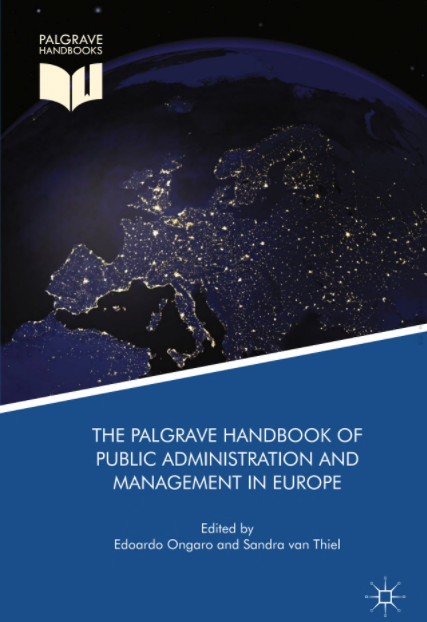 Tobin Im. (2018) Post face the significance of the palgrave Handbook of public administration and management in Europe for the Asian Public administration and management community: The pleasure of rediscovering European public administration.
Tobin Im. (2018) Post face the significance of the palgrave Handbook of public administration and management in Europe for the Asian Public administration and management community: The pleasure of rediscovering European public administration.Tobin Im. (2017/11). Post face the significance of the palgrave Handbook of public administration and management in Europe for the Asian Public administration and management community: The pleasure of rediscovering European public administration In Ongaro, E., & Van Thiel, S. (Eds.). The Palgrave Handbook of Public Administration and Management in Europe: Palgrave Macmillan. This Handbook offers a systematic review of state-of-the-art knowledge on public administration in Europe. Covering the theoretical, epistemological and practical aspects of the field, it focuses on how public administration operates and is studied in European countries. In sixty-three chapters, written by leading scholars, this Handbook considers the uniqueness of the European situation through an interdisciplinary and comparative lens, focusing on the administrative diversity which results from the multiplicity of countries, languages, schools of thought and streams of investigation across Europe. It addresses issues such as multi-level administration and governance, intensive cross country cooperation in administrative reform policy, and public accountability under different systems. It also considers the issue of welfare service delivery, at a time of major economic and societal challenges, as well as understudied emerging issues like Islamic Public Administration and the dynamics of public sector negotiations. With contributions from key experts in Public Administration and Public Management, this cutting edge Handbook offers a significant contribution to the field of comparative public administration, policy and management. Read pp.1263-1271
2024-03-22
Read More -
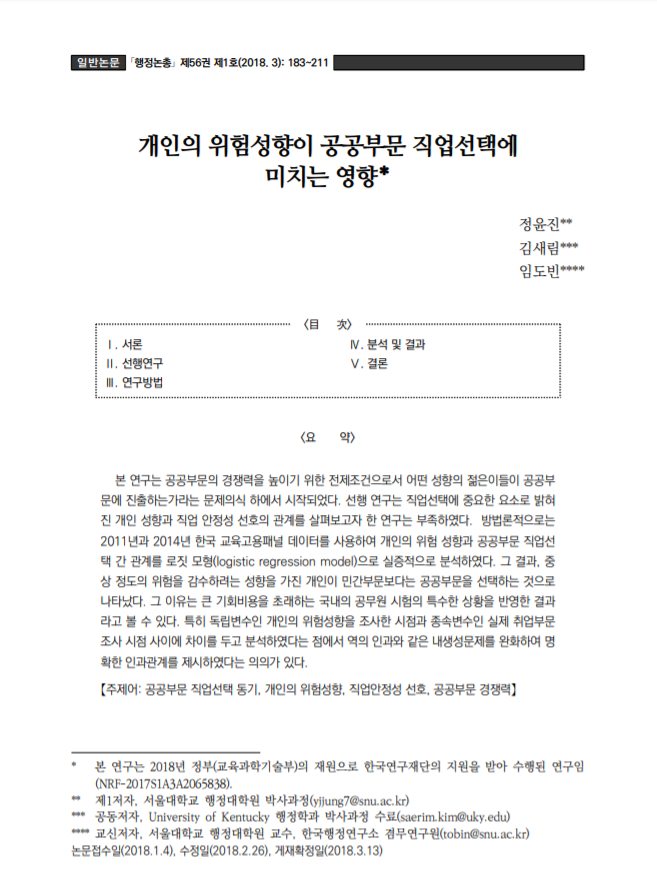 Yunjin Jung, Saerim Kim, Tobin Im. (2018) Risk Aversion and Sorting into the Public Sector: Evidence from South Korea KOREAN JOURNAL OF PUBLIC ADMINISTRATION/ Vol.56 No.1. 183-211
Yunjin Jung, Saerim Kim, Tobin Im. (2018) Risk Aversion and Sorting into the Public Sector: Evidence from South Korea KOREAN JOURNAL OF PUBLIC ADMINISTRATION/ Vol.56 No.1. 183-211Young job seekers in South Korea who witnessed the financial crisis in the late 1990s, the so-called International Monetary Fund (IMF) Crisis, have naturally recognized job security as an important factor in job choice. Consequently, they have favored public sector jobs as these jobs tend to come with greater security. Furthermore, previous research has mainly focused on socioeconomic factors, like the IMF Crisis, influencing the preference for high job security among job seekers rather than on in-depth study of the internal individual characteristics, such as risk preference. This study uses a logistic regression model to examine the relationship between personal risk perception and public-sector job choice using Korean Education & Employment Panel (KEEP) data from 2011 and 2014. The empirical results show that job seekers who have a high-risk preference appeared to choose the public sector as their career choice. This result reflects the special circumstances of the domestic civil service examination, which requires a large opportunity cost. This study mitigates endogeneities and provides a clear causal relationship by analyzing different survey points between the time of examining the individual's risk propensity as an explanatory variable and the actual employment as a dependent variable. 【Keywords:Public Sector Job Choice, Individual Risk Propensity, Job Security, Public Sector Competitiveness】
2024-03-22
Read More -
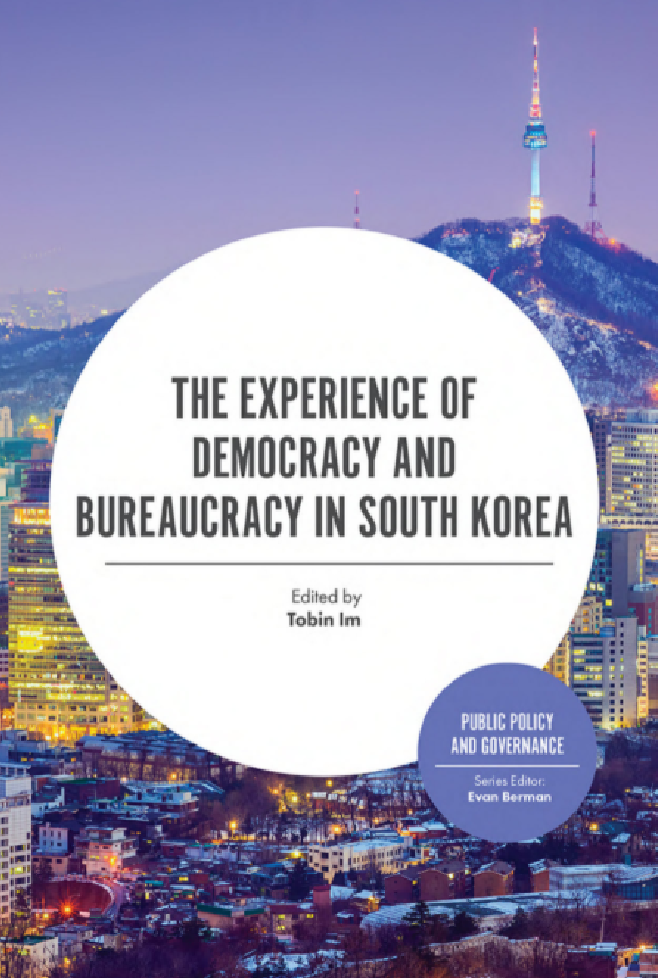 Tobin Im(Ed.). (2017) The Experience of Democracy and Bureaucracy in South Korea Emerald Group Publishing.
Tobin Im(Ed.). (2017) The Experience of Democracy and Bureaucracy in South Korea Emerald Group Publishing.The Experience of Democracy and Bureaucracy in South Korea Edited Tobin Im, Seoul National University, Korea 9781787144729 | 296 pages | Hardback | £66.95 €89.95 $114.95 http://bit.ly/2zlTE8d Save 30% with promo code EMERALD30 South Korea is renowned as one of the success stories of fast economic development. The Korean developmental state was a highly efficient, meritocratic, and fully monopolized coercive force. These resources were skilfully leveraged to shape the direction of private sector actors towards strategic initiatives. However, these very same resources could have resulted in the bureaucracy retaining its power indefinitely. Instead, step-by-step, the resources of the bureaucracy, which serviced the authoritarian leadership in the developmental period, were exercised towards democratization. What were the conditions that made this transformation possible? The Experience of Democracy and Bureaucracy in South Korea addresses this question, filling the existing gap in the academic literature and presenting political implications. It explores the ways in which bureaucracy may not only be compatible with democracy but, more ambitiously, the conditions under which it can enhance it. The chapters examine the unique systems and institutions of the Korean bureaucracy including the National Election Commission, the police force, local government, the ceiling recruitment strategy, and procurement policy. This timely collection will be of interest to researchers, graduate and undergraduate students in public administration and policy. It will also be a useful reference for bureaucrats in developing countries who seek to design policy for bureaucracy in concurrence with democratization. Read chapter 1 “Revisiting Bureaucratic Dysfunction: The Role of Bureaucracy in Democratization” by Tobin Im free online now http://bit.ly/2A53Dfo Order direct from the publisher and save 30% with promo code EMERALD30 http://bit.ly/2zlTE8d
2024-03-22
Read More -
 Im, Tobin., & Hartley, K. . (2017) Aligning Needs and Capacities to Boost Government Competitiveness Public Organization Review. Online Published
Im, Tobin., & Hartley, K. . (2017) Aligning Needs and Capacities to Boost Government Competitiveness Public Organization Review. Online PublishedNational competitiveness indices are often theoretical underdeveloped, limiting their engagement with academic literature. Because many are based on neoliberal ideology, a new approach is needed to incorporate governance and administration theory, and to enhance relevance to developing countries. This article introduces government competitiveness, a concept that recognizes overlooked factors like the role of social organizations, the use of diverse policy inputs and policy development processes, and the imperative to address human needs at all development stages. The conceptual foundation draws from systems theory, needs theory, and intervention stages theory to inform a comprehensive framework that bridges development scholarship and practice.
2024-03-22
Read More -
 Автор рецензии. (2017) Book Reivew: Публичные организации в Азии(Public Organizations in Asia) Электронный научный журнал(Electronic Scientific Journal) / 46(5). 33-36
Автор рецензии. (2017) Book Reivew: Публичные организации в Азии(Public Organizations in Asia) Электронный научный журнал(Electronic Scientific Journal) / 46(5). 33-36access: http://old.niu.ranepa.ru/nauka/wp-content/uploads/2017/12/05_2017.pdf
2024-03-22
Read More -
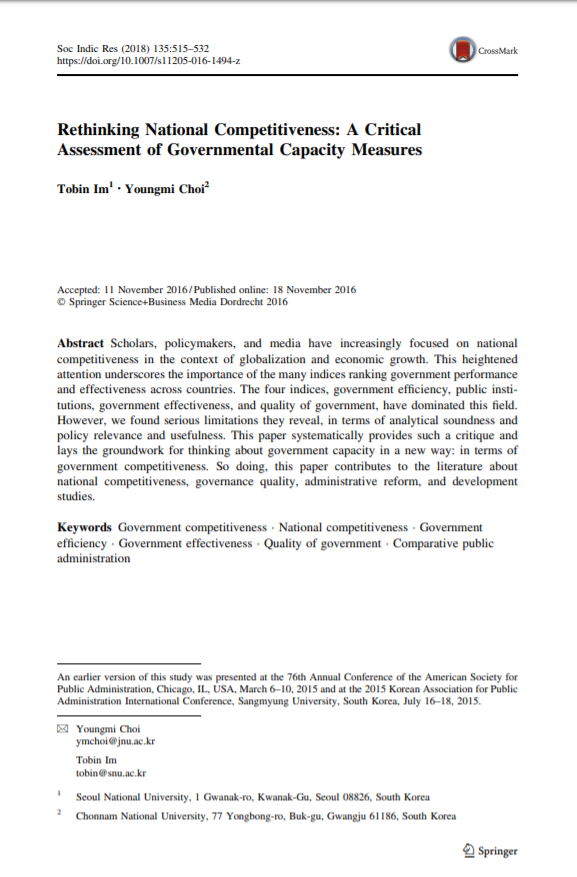 Im., T. & Choi, Y. . (2016) Rethinking National Competitiveness: A Critical Assessment of Governmental Capacity Measures Social Indicators Research. Online Published
Im., T. & Choi, Y. . (2016) Rethinking National Competitiveness: A Critical Assessment of Governmental Capacity Measures Social Indicators Research. Online PublishedScholars, policymakers, and media have increasingly focused on national competitiveness in the context of globalization and economic growth. This heightened attention underscores the importance of the many indices ranking government performance and effectiveness across countries. The four indices, government efficiency, public institutions, government effectiveness, and quality of government, have dominated this field. However, we found serious limitations they reveal, in terms of analytical soundness and policy relevance and usefulness. This paper systematically provides such a critique and lays the groundwork for thinking about government capacity in a new way: in terms of government competitiveness. So doing, this paper contributes to the literature about national competitiveness, governance quality, administrative reform, and development studies.
2024-03-22
Read More -
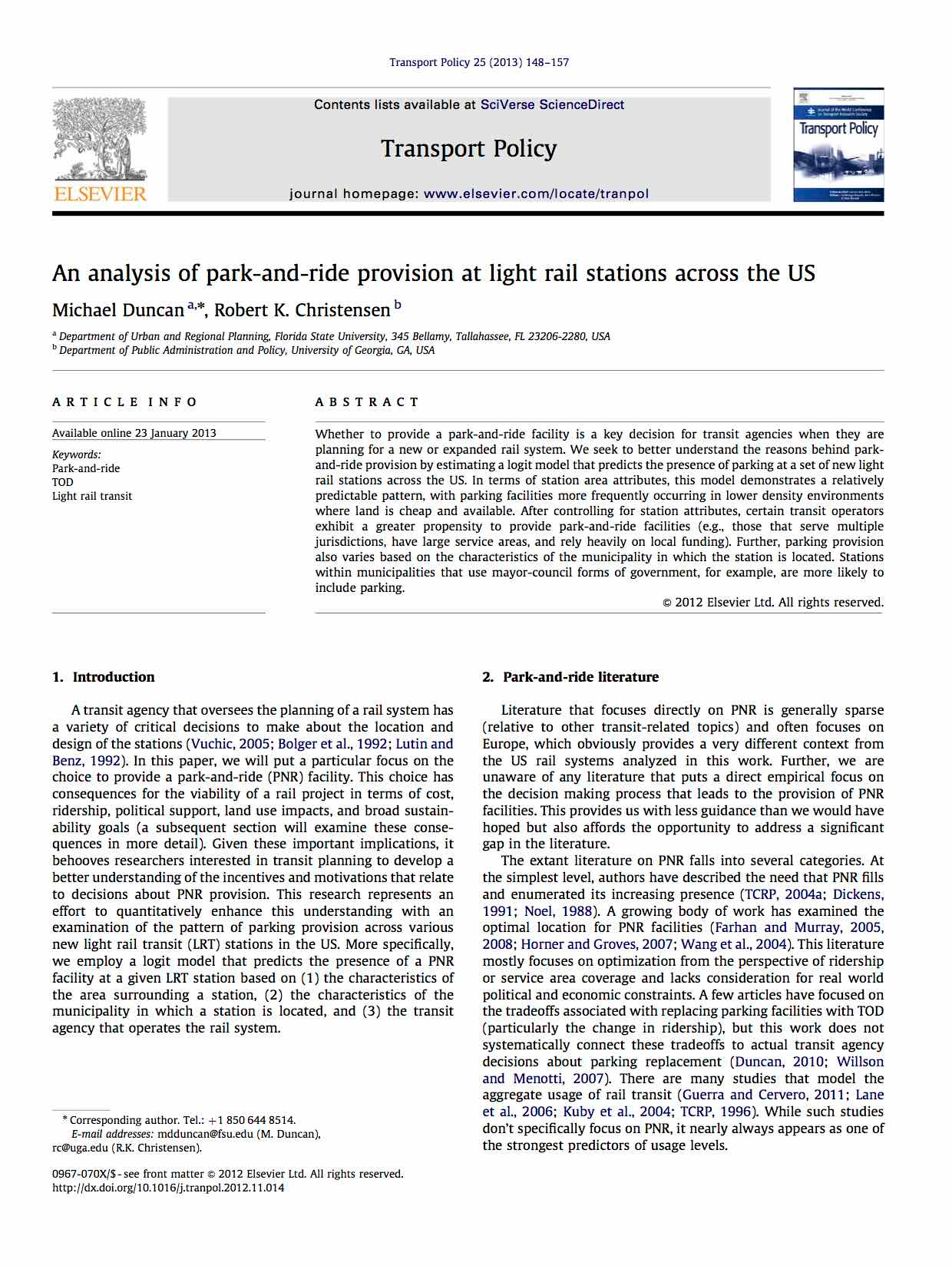 Michael Duncan and Robert K. Christensen. (2013) An analysis of park-and-ride provision at light rail stations across the US. Transport Policy 25. 148-157
Michael Duncan and Robert K. Christensen. (2013) An analysis of park-and-ride provision at light rail stations across the US. Transport Policy 25. 148-157Whether to provide a park-and-ride facility is a key decision for transit agencies when they are planning for a new or expanded rail system. We seek to better understand the reasons behind park-and-ride provision by estimating a logit model that predicts the presence of parking at a set of new light rail stations across the US. In terms of station area attributes, this model demonstrates a relatively predictable pattern, with parking facilities more frequently occurring in lower density environments where land is cheap and available. After controlling for station attributes, certain transit operators exhibit a greater propensity to provide park-and-ride facilities (e.g., those that serve multiple jurisdictions, have large service areas, and rely heavily on local funding). Further, parking provision also varies based on the characteristics of the municipality in which the station is located. Stations within municipalities that use mayor-council forms of government, for example, are more likely to include parking.
2024-03-22
Read More -
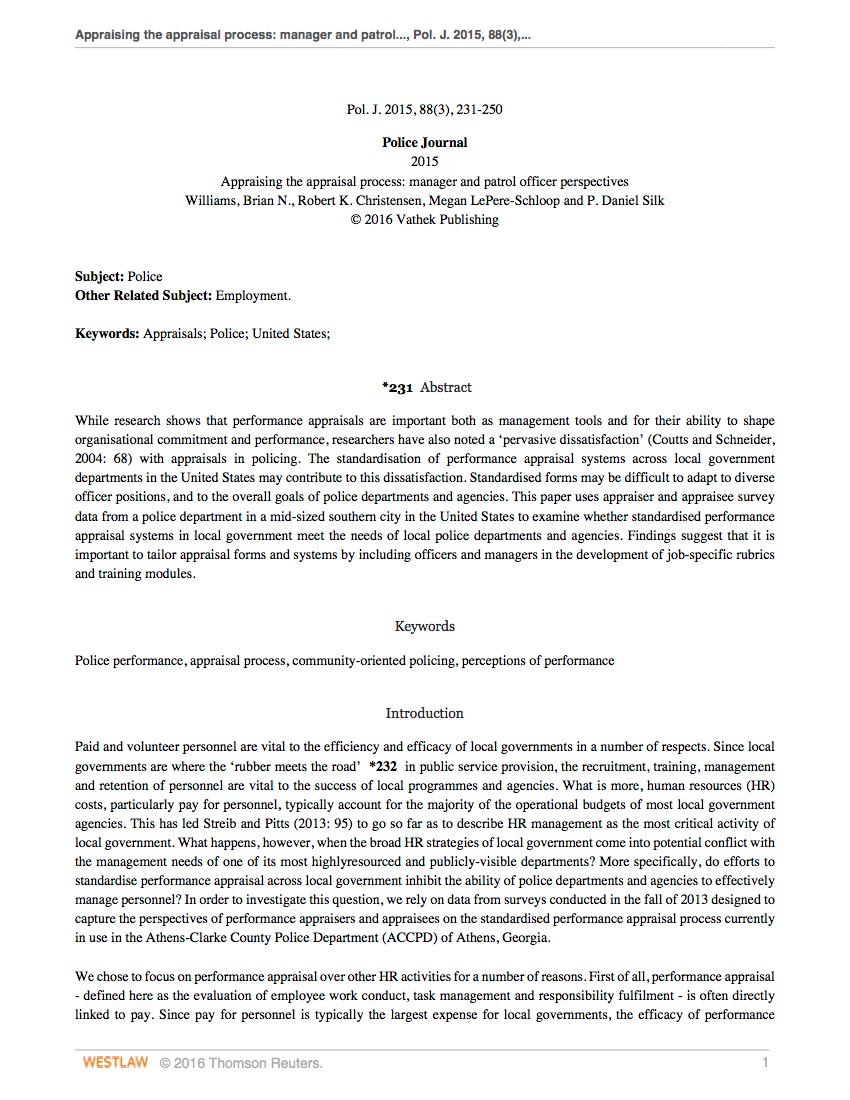 Megan LePere-Schloop, Brian N. Williams, Robert K. Christensen, and Daniel Silk. (2016) Appraising the appraisal process: manager and patrol officer perspectives. Police Journal 88(3). 231-250
Megan LePere-Schloop, Brian N. Williams, Robert K. Christensen, and Daniel Silk. (2016) Appraising the appraisal process: manager and patrol officer perspectives. Police Journal 88(3). 231-250While research shows that performance appraisals are important both as management tools and for their ability to shape organisational commitment and performance, researchers have also noted a ‘pervasive dissatisfaction’ (Coutts and Schneider, 2004: 68) with appraisals in policing. The standardisation of performance appraisal systems across local government departments in the United States may contribute to this dissatisfaction. Standardised forms may be difficult to adapt to diverse officer positions, and to the overall goals of police departments and agencies. This paper uses appraiser and appraisee survey data from a police department in a mid-sized southern city in the United States to examine whether standardised performance appraisal systems in local government meet the needs of local police departments and agencies. Findings suggest that it is important to tailor appraisal forms and systems by including officers and managers in the development of job-specific rubrics and training modules.
2024-03-22
Read More -
 John Szmer, Robert K. Christensen and Erin B. Kaheny. (2015) Gender, Race, and Dissensus on State Supreme Courts Social Science Quarterly 96(2). 553-575
John Szmer, Robert K. Christensen and Erin B. Kaheny. (2015) Gender, Race, and Dissensus on State Supreme Courts Social Science Quarterly 96(2). 553-575Objectives. The objectives of this study were to integrate multiple streams of research on judicial dissensus to better understand the causes of state court of last resort justices’ decisions to dissent. The study particularly focused on the relationship between dissent and gender and race (and their intersection) at the individual and panel level. Methods. We employed probit regression with clustered standard errors of the population of state court of last resort cases from 1995 to 1998. Results. Women and minorities were more likely to dissent in cases involving issues that are particularly salient to those particular groups. We also find evidence of the intersectionality of race and gender: while white women and African-American males were less likely to dissent than white males, African-American women were the most likely to cast dissenting votes. Conclusions. Our results suggest that, in addition to small-group (panel) and institutional characteristics, individual attributes such as race and gender (and their intersection) matter in the decision to dissent.
2024-03-22
Read More -
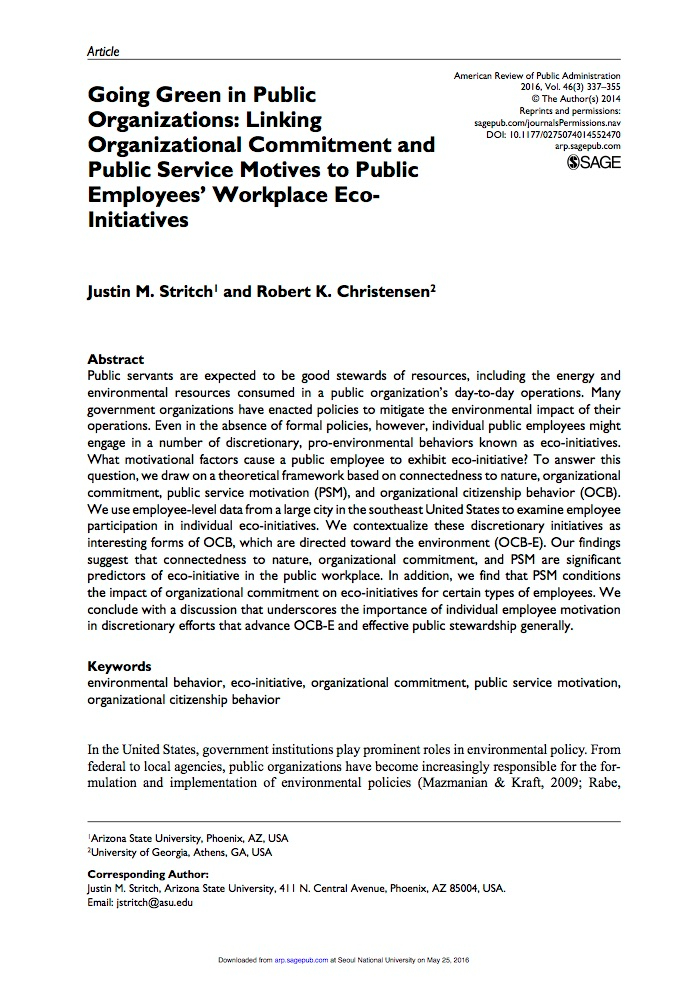 Justin M. Stritch and Robert K. Christensen. (2016) Going Green in Public Organizations Linking Organizational Commitment and Public Service Motives to Public Employees’ Workplace Eco-Initiatives. American Review of Public Administration 46(3). 337-355
Justin M. Stritch and Robert K. Christensen. (2016) Going Green in Public Organizations Linking Organizational Commitment and Public Service Motives to Public Employees’ Workplace Eco-Initiatives. American Review of Public Administration 46(3). 337-355Public servants are expected to be good stewards of resources, including the energy and environmental resources consumed in a public organization’s day-to-day operations. Many government organizations have enacted policies to mitigate the environmental impact of their operations. Even in the absence of formal policies, however, individual public employees might engage in a number of discretionary, pro-environmental behaviors known as eco-initiatives. What motivational factors cause a public employee to exhibit eco-initiative? To answer this question, we draw on a theoretical framework based on connectedness to nature, organizational commitment, public service motivation (PSM), and organizational citizenship behavior (OCB). We use employee-level data from a large city in the southeast United States to examine employee participation in individual eco-initiatives. We contextualize these discretionary initiatives as interesting forms of OCB, which are directed toward the environment (OCB-E). Our findings suggest that connectedness to nature, organizational commitment, and PSM are significant predictors of eco-initiative in the public workplace. In addition, we find that PSM conditions the impact of organizational commitment on eco-initiatives for certain types of employees. We conclude with a discussion that underscores the importance of individual employee motivation in discretionary efforts that advance OCB-E and effective public stewardship generally.
2024-03-22
Read More -
 Robert K. Christensen, Justin M. Stritch, J. Edward Kellough, and Gene A. Brewer. (2015) Identifying Student Traits and Motives to Service-Learn: Public Service Orientation Among New College Freshmen. Journal of Higher Education Outreach and Engagement 19(4).
Robert K. Christensen, Justin M. Stritch, J. Edward Kellough, and Gene A. Brewer. (2015) Identifying Student Traits and Motives to Service-Learn: Public Service Orientation Among New College Freshmen. Journal of Higher Education Outreach and Engagement 19(4).Among college students, public service motives in uence choice of major or job. Although the link between public service motives and prosocial behavior has been established among working adults, researchers have not adequately examined how these motives a ect the reported behavior of precareer students. In this article, the authors explored how public service motives and certain demographic characteristics were related to the service orientation of college freshmen. More speci cally, they exam- ined whether public service motivation was related to a student’s proclivity to enroll in service-learning courses and volunteer frequently. Results indicated that public service motives were positively associated with both curricular and extracurricular public service activities among rst-year college students. Race and gender were found to be key traits a ecting engagement. e implications of these ndings for public service research and education are discussed.
2024-03-22
Read More -
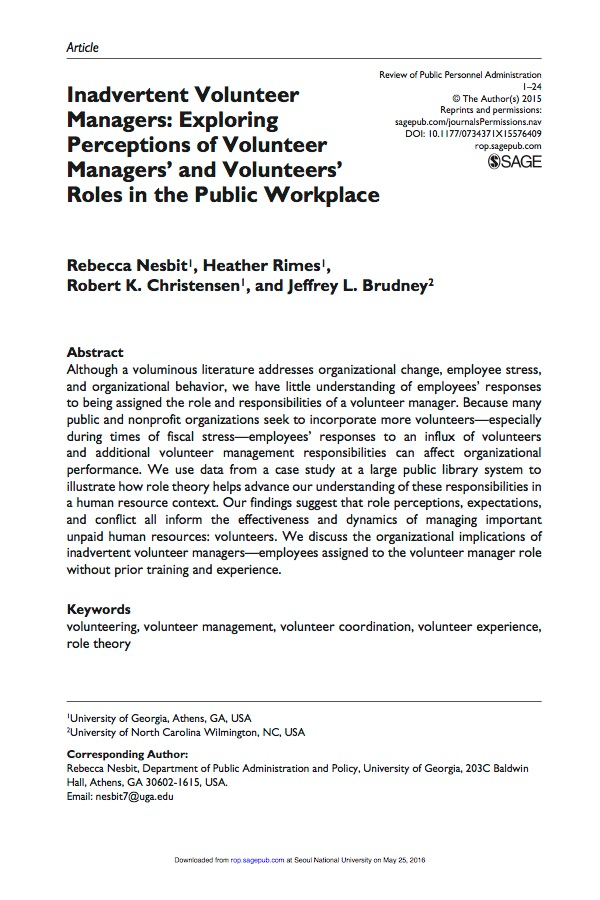 Rebecca Nesbit, Heather Rimes, Robert K. Christensen, and Jeffrey L. Brudney. (2016) Inadvertent Volunteer Managers Exploring Perceptions of Volunteer Managers’ and Volunteers’ Roles in the Public Workplace. Review of Public Personnel Administration. 1-24
Rebecca Nesbit, Heather Rimes, Robert K. Christensen, and Jeffrey L. Brudney. (2016) Inadvertent Volunteer Managers Exploring Perceptions of Volunteer Managers’ and Volunteers’ Roles in the Public Workplace. Review of Public Personnel Administration. 1-24Although a voluminous literature addresses organizational change, employee stress, and organizational behavior, we have little understanding of employees’ responses to being assigned the role and responsibilities of a volunteer manager. Because many public and nonprofit organizations seek to incorporate more volunteers—especially during times of fiscal stress—employees’ responses to an influx of volunteers and additional volunteer management responsibilities can affect organizational performance. We use data from a case study at a large public library system to illustrate how role theory helps advance our understanding of these responsibilities in a human resource context. Our findings suggest that role perceptions, expectations, and conflict all inform the effectiveness and dynamics of managing important unpaid human resources: volunteers. We discuss the organizational implications of inadvertent volunteer managers—employees assigned to the volunteer manager role without prior training and experience.
2024-03-21
Read More -
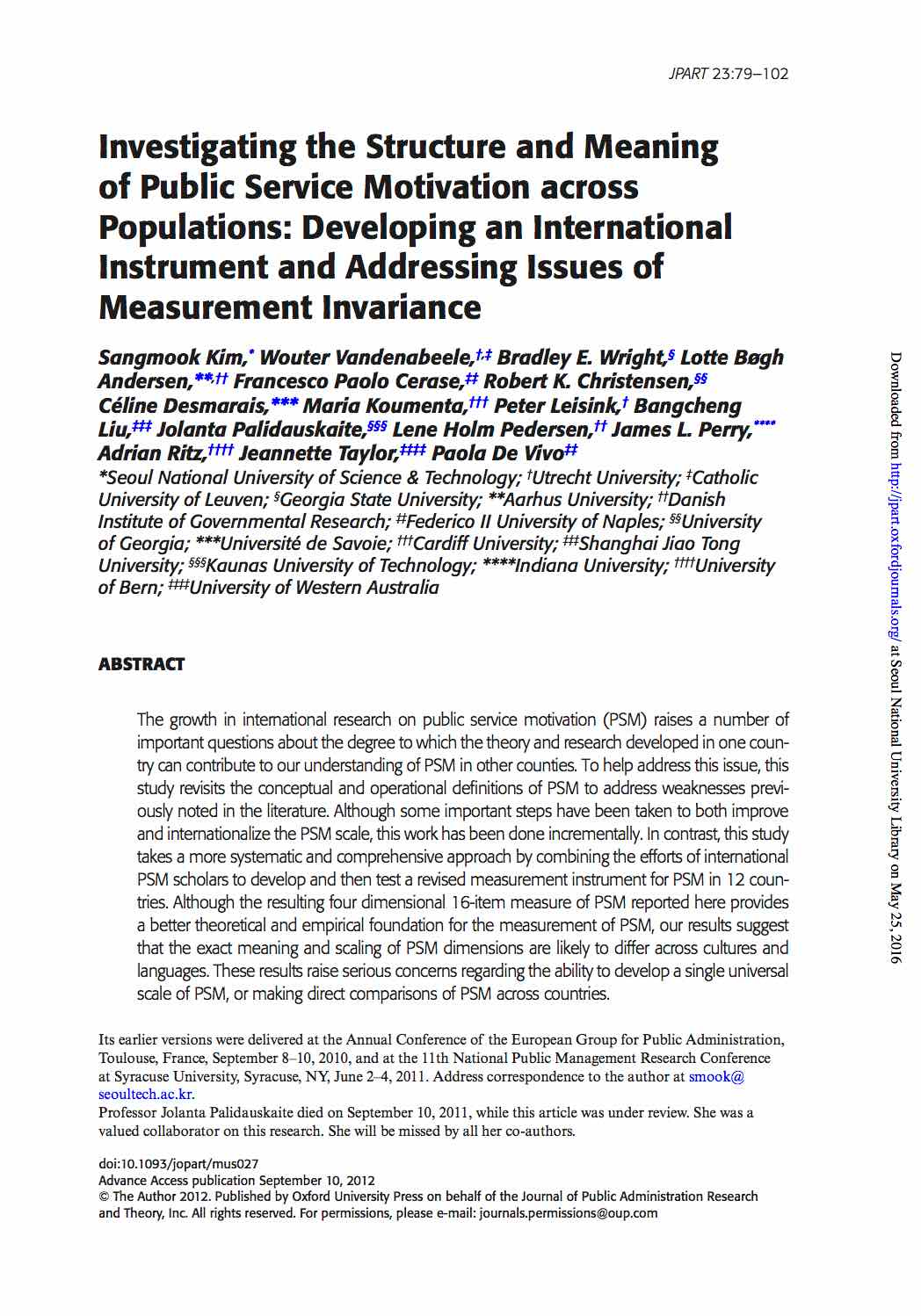 Songmook Kim, Robert K. Christensen et al.. (2013) Investigating the Structure and Meaning of Public Service Motivation across Populations: Developing an International Instrument and Addressing Issues of Measurement Invariance. Journal of Public Administration Research and Theory 23(1). 79-102
Songmook Kim, Robert K. Christensen et al.. (2013) Investigating the Structure and Meaning of Public Service Motivation across Populations: Developing an International Instrument and Addressing Issues of Measurement Invariance. Journal of Public Administration Research and Theory 23(1). 79-102The growth in international research on public service motivation (PSM) raises a number of important questions about the degree to which the theory and research developed in one country can contribute to our understanding of PSM in other counties. To help address this issue, this study revisits the conceptual and operational definitions of PSM to address weaknesses previously noted in the literature. Although some important steps have been taken to both improve and internationalize the PSM scale, this work has been done incrementally. In contrast, this study takes a more systematic and comprehensive approach by combining the efforts of international PSM scholars to develop and then test a revised measurement instrument for PSM in 12 countries. Although the resulting four dimensional 16-item measure of PSM reported here provides a better theoretical and empirical foundation for the measurement of PSM, our results suggest that the exact meaning and scaling of PSM dimensions are likely to differ across cultures and languages. These results raise serious concerns regarding the ability to develop a single universal scale of PSM, or making direct comparisons of PSM across countries.
2024-03-21
Read More -
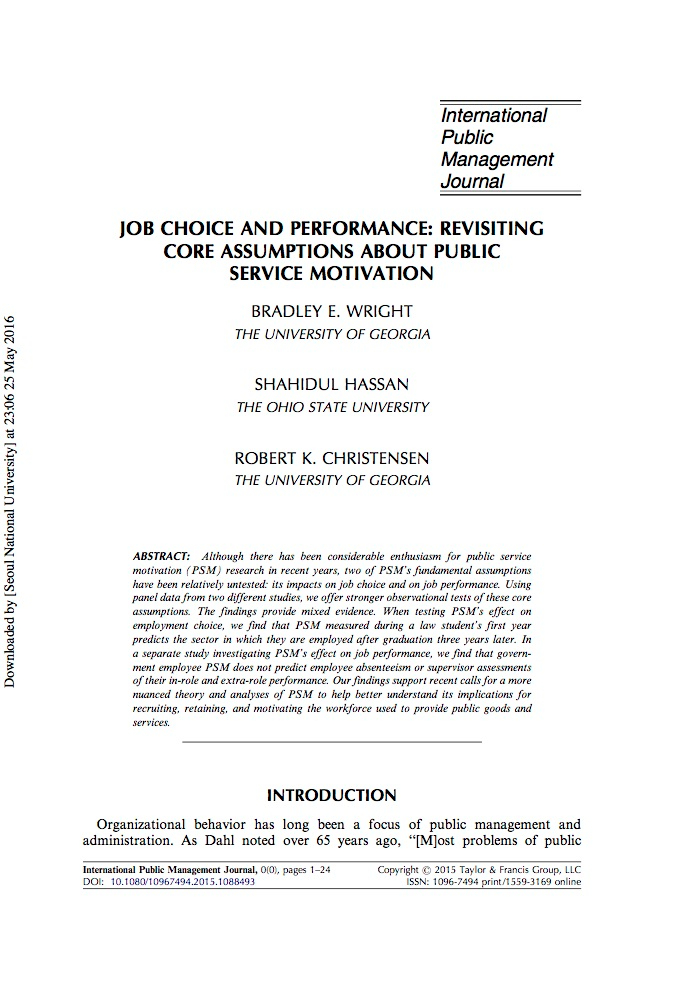 Bradley E. Wright, Shahidul Hassan and Robert K. Christensen. (2016) Job Choice and Performance: Revisiting Core Assumptions about Public Service Motivation. International Public Management Journal. 1-24
Bradley E. Wright, Shahidul Hassan and Robert K. Christensen. (2016) Job Choice and Performance: Revisiting Core Assumptions about Public Service Motivation. International Public Management Journal. 1-24Although there has been considerable enthusiasm for public service motivation (PSM) research in recent years, two of PSM's fundamental assumptions have been relatively untested: its impacts on job choice and on job performance. Using panel data from two different studies, we offer stronger observational tests of these core assumptions. The findings provide mixed evidence. When testing PSM's effect on employment choice, we find that PSM measured during a law student's first year predicts the sector in which they are employed after graduation three years later. In a separate study investigating PSM's effect on job performance, we find that government employee PSM does not predict employee absenteeism or supervisor assessments of their in-role and extra-role performance. Our findings support recent calls for a more nuanced theory and analyses of PSM to help better understand its implications for recruiting, retaining, and motivating the workforce used to provide public goods and services.
2024-03-21
Read More -
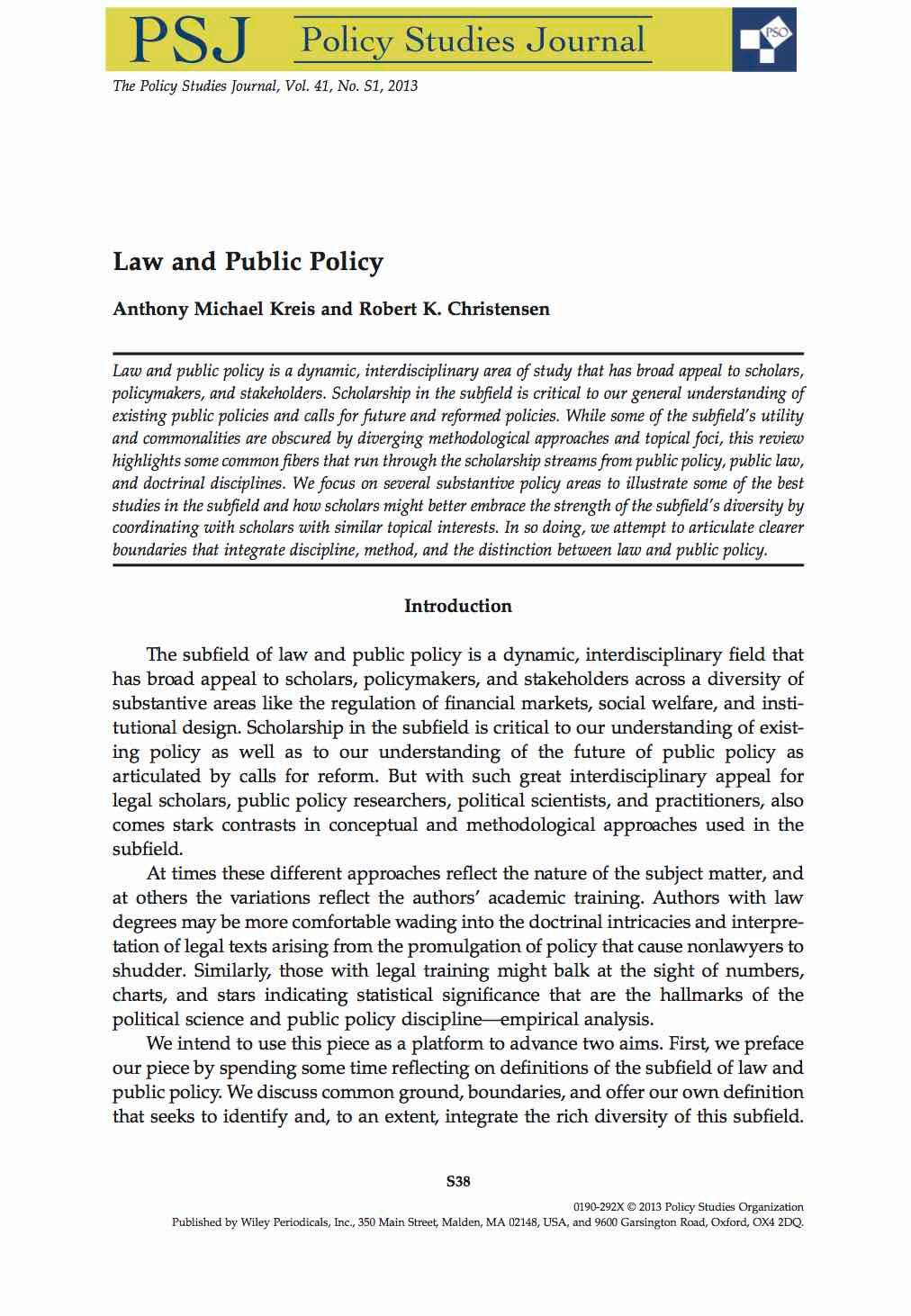 Anthony Michael Kreis and Robert K. Christensen. (2013) Law and Public Policy. Policy Studies Journal 41. S38-S52
Anthony Michael Kreis and Robert K. Christensen. (2013) Law and Public Policy. Policy Studies Journal 41. S38-S52Law and public policy is a dynamic, interdisciplinary area of study that has broad appeal to scholars, policymakers, and stakeholders. Scholarship in the subfield is critical to our general understanding of existing public policies and calls for future and reformed policies. While some of the subfield’s utility and commonalities are obscured by diverging methodological approaches and topical foci, this review highlights some common fibers that run through the scholarship streams from public policy, public law, and doctrinal disciplines. We focus on several substantive policy areas to illustrate some of the best studies in the subfield and how scholars might better embrace the strength of the subfield’s diversity by coordinating with scholars with similar topical interests. In so doing, we attempt to articulate clearer boundaries that integrate discipline, method, and the distinction between law and public policy.
2024-03-21
Read More -
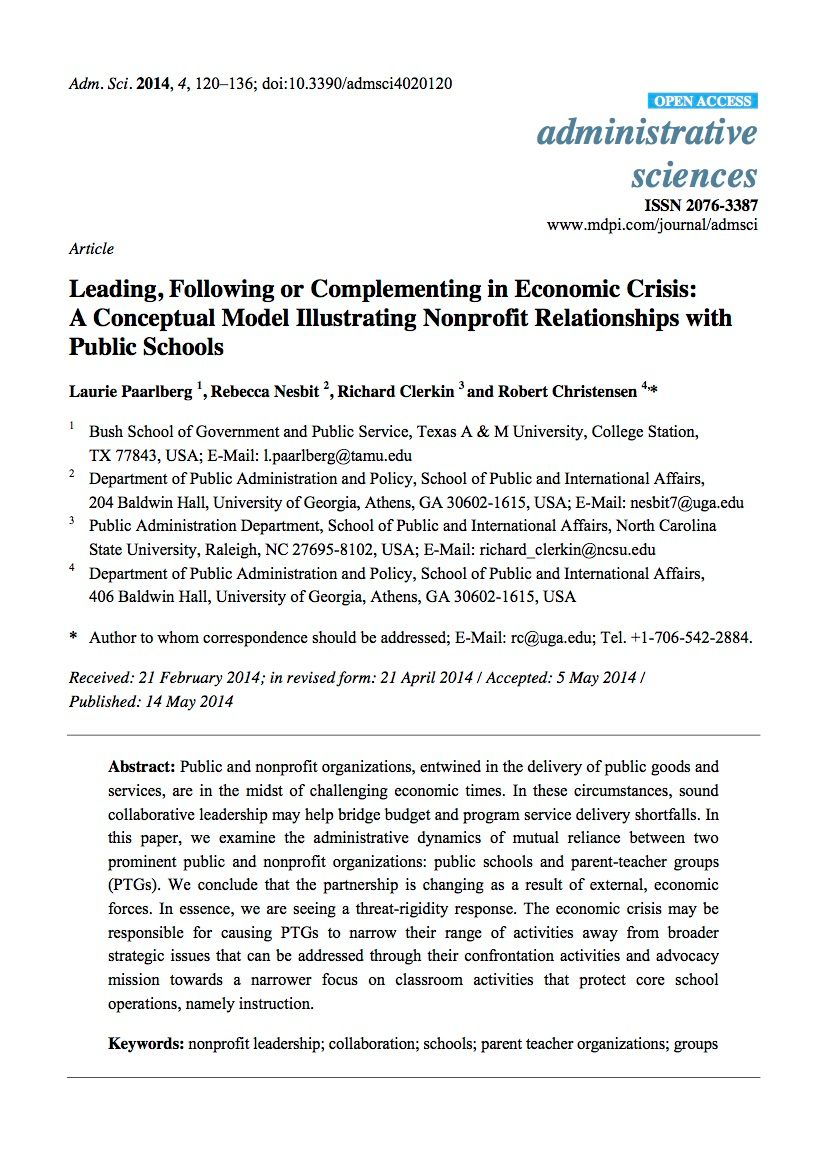 Laurie Paarlberg, Rebecca Nesbit, Richard Clerkin and Robert Christensen. (2014) Leading, Following or Complementing in Economic Crisis: A Conceptual Model Illustrating Nonprofit Relationships with Public Schools. Administrative Sciences 4(2). 120-136
Laurie Paarlberg, Rebecca Nesbit, Richard Clerkin and Robert Christensen. (2014) Leading, Following or Complementing in Economic Crisis: A Conceptual Model Illustrating Nonprofit Relationships with Public Schools. Administrative Sciences 4(2). 120-136Public and nonprofit organizations, entwined in the delivery of public goods and services, are in the midst of challenging economic times. In these circumstances, sound collaborative leadership may help bridge budget and program service delivery shortfalls. In this paper, we examine the administrative dynamics of mutual reliance between two prominent public and nonprofit organizations: public schools and parent-teacher groups (PTGs). We conclude that the partnership is changing as a result of external, economic forces. In essence, we are seeing a threat-rigidity response. The economic crisis may be responsible for causing PTGs to narrow their range of activities away from broader strategic issues that can be addressed through their confrontation activities and advocacy mission towards a narrower focus on classroom activities that protect core school operations, namely instruction.
2024-03-21
Read More -
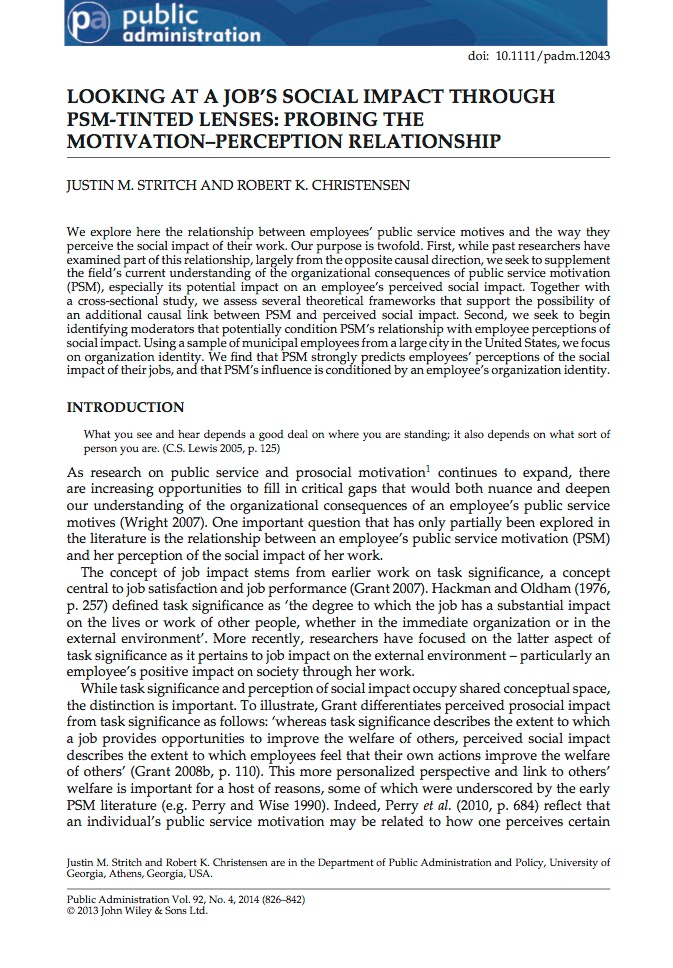 Justin M. Stritch and Robert K. Christensen. (2014) Looking at a job’s social impact through PSM tinted lenses: Probing the motivation – perception relationship. Public Administration 92(4). 826-842
Justin M. Stritch and Robert K. Christensen. (2014) Looking at a job’s social impact through PSM tinted lenses: Probing the motivation – perception relationship. Public Administration 92(4). 826-842We explore here the relationship between employees' public service motives and the way they perceive the social impact of their work. Our purpose is twofold. First, while past researchers have examined part of this relationship, largely from the opposite causal direction, we seek to supplement the field's current understanding of the organizational consequences of public service motivation (PSM), especially its potential impact on an employee's perceived social impact. Together with a cross-sectional study, we assess several theoretical frameworks that support the possibility of an additional causal link between PSM and perceived social impact. Second, we seek to begin identifying moderators that potentially condition PSM's relationship with employee perceptions of social impact. Using a sample of municipal employees from a large city in the United States, we focus on organization identity. We find that PSM strongly predicts employees' perceptions of the social impact of their jobs, and that PSM's influence is conditioned by an employee's organization identity.
2024-03-21
Read More -
 Bradley E. Wright, Robert K. Christensen and Sanjay K. Pandey. (2013) Measuring Public Service Motivation: Exploring the Equivalence of Existing Global Measures. International Public Management Journal 16(2). 197-223
Bradley E. Wright, Robert K. Christensen and Sanjay K. Pandey. (2013) Measuring Public Service Motivation: Exploring the Equivalence of Existing Global Measures. International Public Management Journal 16(2). 197-223Our ability to interpret, generalize, and build theory across public service motivation (PSM) studies is limited by lack of knowledge regarding the equivalence of different PSM measures that researchers frequently use. While past research has given considerable attention to validating multidimensional measures of PSM, this study investigates the psychometric properties of the global measures that have been used to provide much of the empirical evidence on PSM. Building on the lessons of other research using global and multidimensional measures, we first discuss the strengths and weaknesses of existing global measures of PSM relative to those of the multidimensional measures. After highlighting the potential merit of global scales, we then provide empirical justification for global scales. Using five different data sets to compare commonly used global measures of PSM, our findings suggest that these different measures are not only highly correlated with each other but also display a similar pattern and strength of relationships with important correlates of PSM. These findings suggest that these measures do tap into the same conceptual space and help validate our continued reliance on empirical studies that have used different measures to build our understanding of PSM.
2024-03-21
Read More -
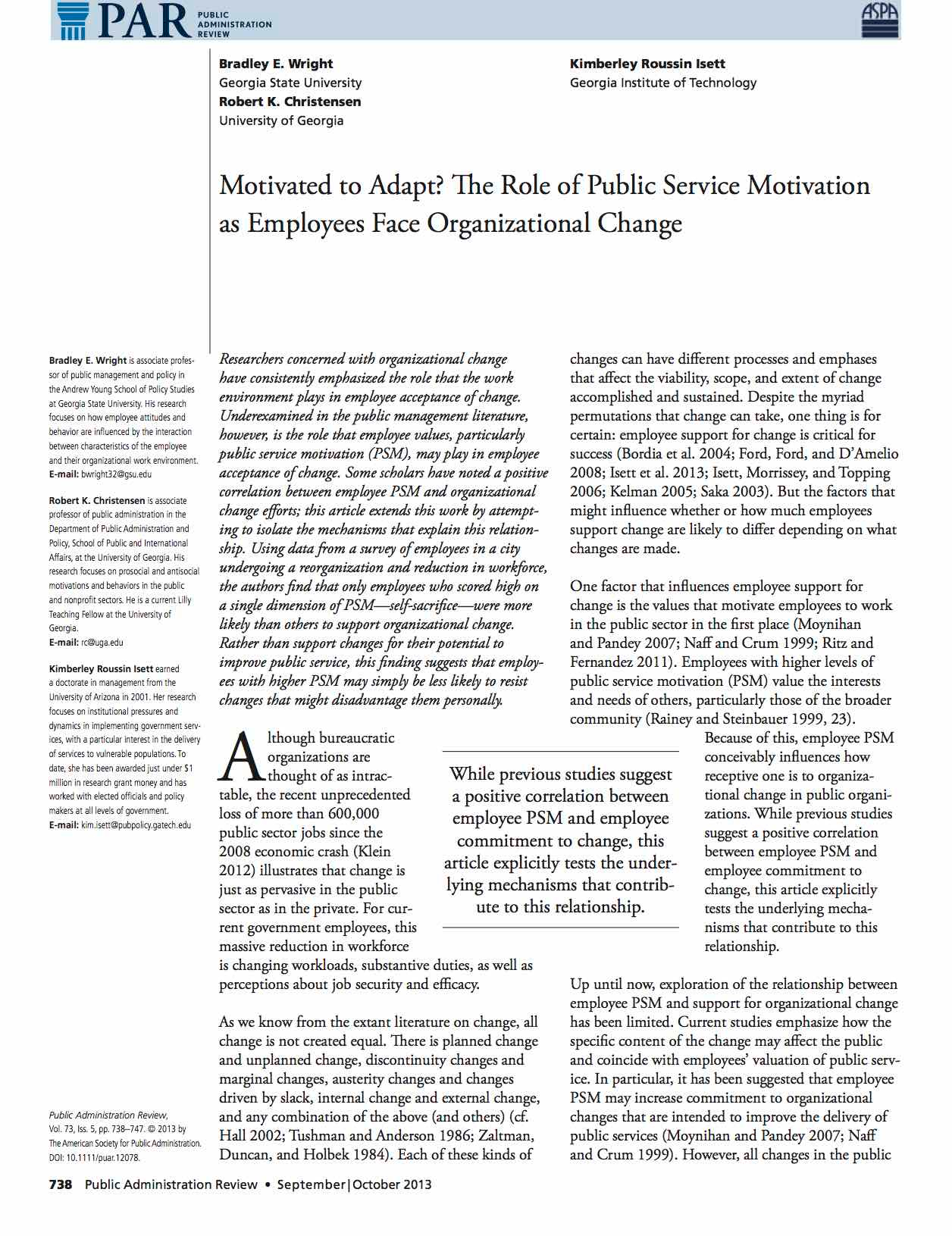 Bradley E. Wright, Robert K. Christensen and Kimberley Roussin Isett. (2013) Motivated to Adapt? The Role of Public Service Motivation as Employees Face Organizational Change. Public Administration Review 73(5). 738-747
Bradley E. Wright, Robert K. Christensen and Kimberley Roussin Isett. (2013) Motivated to Adapt? The Role of Public Service Motivation as Employees Face Organizational Change. Public Administration Review 73(5). 738-747Researchers concerned with organizational change have consistently emphasized the role that the work environment plays in employee acceptance of change. Underexamined in the public management literature, however, is the role that employee values, particularly public service motivation (PSM), may play in employee acceptance of change. Some scholars have noted a positive correlation between employee PSM and organizational change efforts; this article extends this work by attempting to isolate the mechanisms that explain this relationship. Using data from a survey of employees in a city undergoing a reorganization and reduction in workforce, the authors find that only employees who scored high on a single dimension of PSM—self-sacrifice—were more likely than others to support organizational change. Rather than support changes for their potential to improve public service, this finding suggests that employees with higher PSM may simply be less likely to resist changes that might disadvantage them personally.
2024-03-21
Read More -
 Richard M. Clerkin, Laurie E. Paarlberg, Robert K. Christensen, Rebecca A. Nesbit and Mary Tschirhart. (2013) Place, Time, and Philanthropy: Exploring Geographic Mobility and Philanthropic Engagement. Public Administration Review 73(1). 97-106
Richard M. Clerkin, Laurie E. Paarlberg, Robert K. Christensen, Rebecca A. Nesbit and Mary Tschirhart. (2013) Place, Time, and Philanthropy: Exploring Geographic Mobility and Philanthropic Engagement. Public Administration Review 73(1). 97-106America is a nation of movers, and this has implications for public and nonprofit managers who rely on donations and volunteers to increase the capacity of nonprofits and to strengthen local communities. This article explores the impact of time and place on philanthropic engagement, focusing on how three aspects of community—sense of belonging, social connections, and regional culture—are related to volunteering and giving to local organizations. The authors find that geographic mobility affects philanthropic engagement. Drawing on a survey of active older Americans, the authors find that three community factors —sense of community, social networks, and regional cultures— are related to one or both types of philanthropic behavior. The authors conclude by offering thoughts for future research and practice.
2024-03-21
Read More

